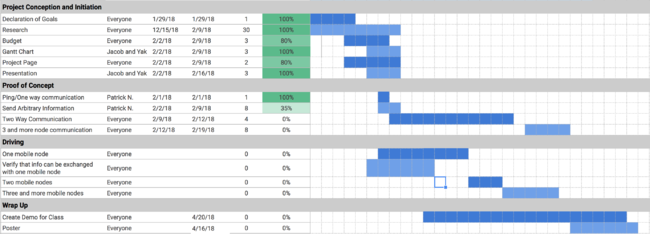Pi Car Comm
Contents
Introduction
Overview
The goal of this project is to establish vehicular communication between a group of PiCars. The end goal is to demonstrate this capability, specifically as it applies to collision avoidance between two or more vehicles.
Members
- Patrick Naughton
- Yak Fishman
- Jacob Cytron
- TA: Sam Hoff
- Instructor: Proffesor Mell
Objectives
- Establish an ad hoc network between many (potentially up to 10, at least 2) Pi Cars
- Use this communication capability to avoid collisions in a demonstration involving at least 2 Pi Cars
Challenges
Data Transfer Rate
As the cars will be moving quickly, one of the main challenges will be ensuring that each car can establish and modify its network extremely quickly. Thus, not just data transfer, but also network establishment speed will be important.
Additionally, simultaneously addressing all valid addresses will be difficult to do efficiently.
Security
Since we're using Wi-Fi, there is a potential for a malicious actor to transmit faulty messages that could trick a car.
Fortunately, since the Pi's and/or cars will not be connected to the internet, a malicious actor would have to be physically close to the car (within the range of the Wi-Fi), substantially limiting the number of potential attackers.
Gantt Chart and Presentation

Budget
Design & Solutions
An instructable on how to build a Pi Car can be found here. It includes parts needed- both 3d printed parts and parts ordered, as well as a step by step guide to putting the car together.
Our GitHub with all code used in this project. Documentation provided
Results
We were able to achieve our bsaeline goal of establishing a network of communication between Pi Cars. They are able to send information between each other just as we hoped
Late in the semester we were informed that we would have less premade cars at our disposal so we had to designate a majority of our project time to get two working cars so we could have a functioning demo